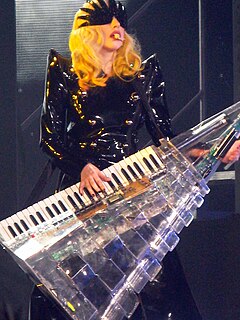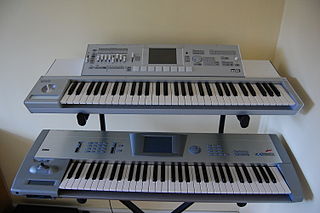Related Research Articles

A digital synthesizer is a synthesizer that uses digital signal processing (DSP) techniques to make musical sounds. This in contrast to older analog synthesizers, which produce music using analog electronics, and samplers, which play back digital recordings of acoustic, electric, or electronic instruments. Some digital synthesizers emulate analog synthesizers; others include sampling capability in addition to digital synthesis.

MIDI is a technical standard that describes a communications protocol, digital interface, and electrical connectors that connect a wide variety of electronic musical instruments, computers, and related audio devices for playing, editing, and recording music. The specification originates in the paper Universal Synthesizer Interface published by Dave Smith and Chet Wood of Sequential Circuits at the 1981 Audio Engineering Society conference in New York City.

Digital music technology encompasses digital instruments, computers, electronic effects units, software, or digital audio equipment by a performer, composer, sound engineer, DJ, or record producer to produce, perform or record music. The term refers to electronic devices, instruments, computer hardware, and software used in performance, playback, recording, composition, mixing, analysis, and editing of music.
A software synthesizer or softsynth is a computer program that generates digital audio, usually for music. Computer software that can create sounds or music is not new, but advances in processing speed now allow softsynths to accomplish the same tasks that previously required the dedicated hardware of a conventional synthesizer. Softsynths may be readily interfaced with other music software such as music sequencers typically in the context of a digital audio workstation. Softsynths are usually less expensive and can be more portable than dedicated hardware.
A music workstation is an electronic musical instrument providing the facilities of:

The Roland D-50 is a synthesizer produced by Roland and released in April 1987. Its features include subtractive synthesis, on-board effects, a joystick for data manipulation, and an analogue synthesis-styled layout design. The external Roland PG-1000 (1987-1990) programmer could also be attached to the D-50 for more complex manipulation of its sounds. It was also produced in a rack-mount variant design, the D-550 (1987-1990), with almost 450 user-adjustable parameters.

Novation Digital Music Systems Ltd. is a British musical equipment manufacturer, founded in 1992 by Ian Jannaway and Mark Thompson as Novation Electronic Music Systems. Today the company specializes in MIDI controllers with and without keyboards, both analog and virtual analog performance synthesizers, grid-based performance controllers, and audio interfaces. At present, Novation products are primarily manufactured in China.

The keytar is a lightweight synthesizer that is supported by a strap around the neck and shoulders, similar to the way a guitar is supported by a strap. Keytars allow players a greater range of movement onstage, compared to conventional keyboards, which are placed on stationary stands or which are part of heavy, floor-mounted structures. The instrument has a musical keyboard for triggering musical notes and sounds. Various controls are placed on the instrument's "neck", including those for pitch bends, vibrato, portamento, and sustain.

The Korg Triton is a music workstation synthesizer, featuring digital sampling and sequencing, released in 1999. It uses Korg's HI Synthesis tone generator and was eventually available in several model variants with numerous upgrade options. The Triton became renowned as a benchmark of keyboard technology, and has been widely featured in music videos and live concerts. At the NAMM 2007, Korg announced the Korg M3 as its successor.

The Roland MT-32 Multi-Timbre Sound Module is a MIDI synthesizer module first released in 1987 by Roland Corporation. It was originally marketed to amateur musicians as a budget external synthesizer with an original list price of $695. However, it became more famous along with its compatible modules as an early de facto standard in computer music. Since it was made prior to the release of the General MIDI standard, it uses its own proprietary format for MIDI file playback.

The Jupiter-8, or JP-8, is an eight-voice polyphonic analog subtractive synthesizer introduced by Roland Corporation in early 1981.

A sound module is an electronic musical instrument without a human-playable interface such as a piano-style musical keyboard. Sound modules have to be operated using an externally connected device, which is often a MIDI controller, of which the most common type is the musical keyboard. Another common way of controlling a sound module is through a sequencer, which is computer hardware or software designed to record and playback control information for sound-generating hardware. Connections between sound modules, controllers, and sequencers are generally made with MIDI, which is a standardized interface designed for this purpose.

David J. Smith is an American engineer and musician and founder of the synthesizer company Sequential. Smith was responsible for the first commercial polyphonic and microprocessor-controlled synthesizer, the Prophet-5, and later the multitimbral synthesizer. He is also referred to as the "Father of MIDI" for his role in the development of MIDI, now a standard interface protocol for electronic instruments and recording/pro audio equipment.

The Korg DW-8000 synthesizer was an eight-voice polyphonic hybrid digital-analog synthesizer 61-note keyboard instrument released in 1985. By the time of its launch Korg had already begun a common trend in 1980s synthesizer design: using numerical codes to access or change parameters with its predecessor - the Korg Poly-61, which was widely regarded as the company's first 'knobless' synthesizer. This was a move away from the heavily laden, complex control panels of earlier designs.

A guitar synthesizer is any one of a number of musical instrument systems that allow a guitarist to access synthesizer capabilities.
The Roland JD-990 Super JD is a module version of Roland JD-800 synthesizer with expanded capabilities, which was released in 1993. JD-990 is a multitimbral synthesizer utilizing 'wave-table' sample-based synthesis technology. It is equipped with 6 MB of ROM containing sampled PCM waveforms, four sets of stereo outputs that are assignable to individual, internal, instruments, and standard MIDI in/out/through ports. JD-990 has a large LCD display and programming takes place through a keypad on the front panel of the unit. The unit can generate multi-timbral sounds reminiscent of the vintage analogue synthesizers but is also capable of generation of modern digital textures. There are several expansion boards available for JD-990 that can be installed in the provided expansion slot in the chassis of the unit.

A synthesizer is an electronic musical instrument that generates audio signals. Synthesizers typically create sounds by generating waveforms, through methods including subtractive synthesis, additive synthesis and frequency modulation synthesis. These sounds may be altered by components such as filters, which cut or boost frequencies; envelopes, which control articulation, or how notes begin and end; and low-frequency oscillators, which modulate parameters such as pitch, volume, or filter characteristics affecting timbre. Synthesizers are typically played with keyboards or controlled by sequencers, software or other instruments, and may be synchronized to other equipment via MIDI.
The Jupiter-80 is a discontinued 256-voice polyphonic virtual analog subtractive introduced by Roland Corporation in 2011. The Jupiter-80 is a part of Roland's flagship long-running synthesizer series, which began with the Jupiter-4 between the years of 1978 and 1981. The Jupiter-80 was shortly followed by the Jupiter-50, which is a combination of both the JP-80 and the JUNO series. It was succeeded by the Jupiter-X and Jupiter-Xm in 2019.
The Roland MKS-20 is a digital piano-type sound module released by Roland Corporation in 1986. It is a rackmount version of the popular 1980s-era Roland RD-1000 digital piano. The RD-1000 has the exact same sound engine mounted in a musical keyboard-type MIDI controller. Both use Roland's "structured adaptive synthesis approach" to provide eight keyboard sounds, including grand piano, electric piano, harpsichord, vibraphone, and clavinet. Both have three effects units built in: stereo chorus, stereo tremolo, and a three-band equalizer with a sweepable mid-range.
References
- ↑ "Roland - JUPITER-50 | Synthesizer".
- ↑ "JUPITER Synth Legends | JUPITER-80 | Axial".
- ↑ Reid, Gordon. "Sound On Sound Review: Roland Jupiter 50". www.soundonsound.com.
- ↑ Lovelace, David (May 8, 2013). "Roland Jupiter-50 Stage Synth Reviewed". www.keyboardmag.com.